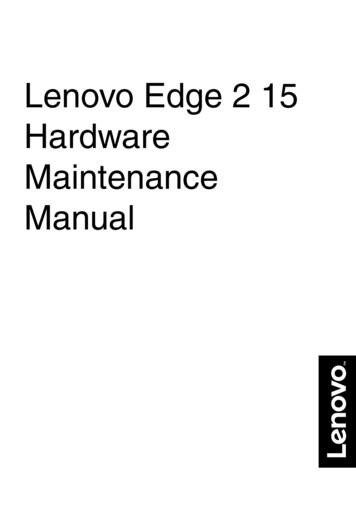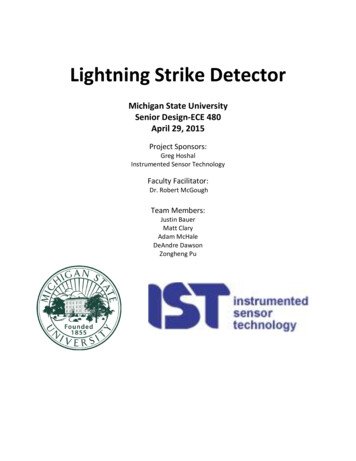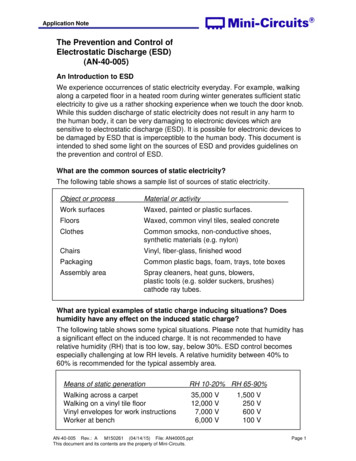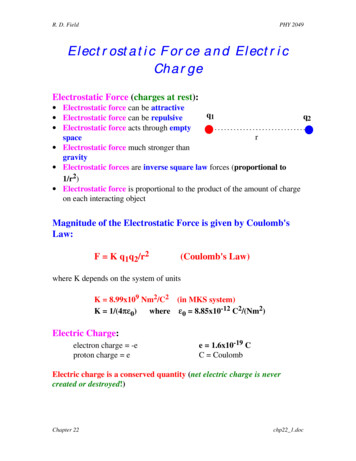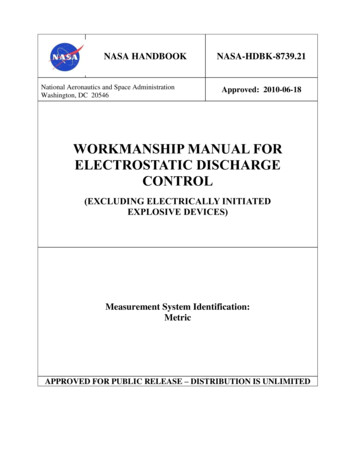
Transcription
NASA HANDBOOKNational Aeronautics and Space AdministrationWashington, DC 20546NASA-HDBK-8739.21Approved: 2010-06-18WORKMANSHIP MANUAL FORELECTROSTATIC DISCHARGECONTROL(EXCLUDING ELECTRICALLY INITIATEDEXPLOSIVE DEVICES)Measurement System Identification:MetricAPPROVED FOR PUBLIC RELEASE – DISTRIBUTION IS UNLIMITED
NASA-HDBK 8739.21This page intentionally left blank.2
NASA-HDBK 8739.21DOCUMENT HISTORY LOGStatusDocumentRevisionApproval DateBaseline-2010-06-18DescriptionInitial ReleaseThis document is derived from GSFC-WM001BJWL4Revalidated2018-04-05Baseline revalidated.3
NASA-HDBK 8739.21This page intentionally left blank.4
NASA-HDBK 8739.21FOREWORDThis NASA-HANDBOOK is published by the National Aeronautics and Space Administration(NASA) to provide standardized guidance for implementing ANSI/ESD S20.20 requirements. Thisdocument:a. Describes basic considerations necessary to ensure ESD protection in work areas to be used withESD-sensitive items.b. Reinforces rigorous operator training best practice.c. May be used by suppliers performing work for NASA to satisfy ANSI/ESD S20.20 ESDimplementation plan requirements.NOTE: For the purpose of this document, the term “supplier” is defined as civil servants andcontractors who are building and delivering ESD-sensitive hardware for NASA Projects.This manual provides the ESD Control Program Plan (CPP) [1] Note1, Compliance Verification, andESD Administrative and Technical Requirements specified in ANSI/ESD S20.20 paragraphs 6.0, 7.0and 8.0. The guides used for the development of this manual were ESD TR20.20 Handbook for theDevelopment of an Electrostatic Discharge Control Program for the Protection of Electronic Parts,Assemblies and Equipment and ESD TR53-01-06 Compliance Verification of ESD ProtectiveEquipment and Materials , published by the ESD Association.Several drawings, tables and paragraphs in this manual have been adopted, with permission from theassociated NASA Center, from pre-existing NASA Center-level ESD implementation plans. Theintent is to facilitate NASA’s and industry’s use of a common minimum baseline in order to maximizethe success of ESD programs that are used in conjunction with the manufacture, test and handling ofESD-sensitive NASA hardware. This document is not intended to prescribe any specific technicalprocedure and/or software tools.This document is controlled and maintained by the NASA Office of Safety and Mission Assurance(OSMA). Comments and questions concerning the contents of this publication should be referred tothe National Aeronautics and Space Administration, Director, Safety and Assurance RequirementsDivision, Office of Safety and Mission Assurance, Washington, DC 20546.//s//Bryan O’ConnorChief, Safety and Mission Assurance18 June 2010Approval DateNote 1: See Section 11 for the list of references. References are noted throughout insuperscripted brackets [ ].5
NASA-HDBK 8739.21This page intentionally left blank.6
NASA-HDBK 8739.21TABLE OF CONTENTS1SCOPE1.11.2234General . 18Electrostatic Discharge (ESD) Technical Overview [15] . 18ESD Sensitivity Levels . 19Declaring the Model and Class Required . 20Personnel Safety [15] . 21ESD Control Program Manager/Coordinator (Required by ANSI/ESDA20.20) . 21ESD Program Monitor . 21ESD Protected Areas (EPA) . 22Temporary, Provisional and Intermittent-Use EPAs . 23ESD Control Program . 24Audits and Inspections . 24TRAINING AND CERTIFICATION PROGRAM . 266.16.26.36.46.57Configuration Control . 16Implementation . 16Records . 17ESD CONTROL PROGRAM . 185.15.25.35.45.55.65.75.85.95.105.116Purpose. 11Applicability . 11APPLICABLE DOCUMENTS . 12DEFINITIONS . 13GENERAL . 164.14.24.35. 11General . 26Training Program . 26Certification of Training Levels . 27Record Maintenance . 28Maintenance of Training and Certification . 28ESD CONTROL REQUIREMENTS FOR FACILITIES . 307.17.27.37.47.57.67.77.87.97.107.117.12General . 30Compliance . 30Traceability . 30Identification and Access - ESD Areas . 30Temporary Use of ESD benches for Non-ESDS Work . 32Prohibited Materials and Activities . 32ESD-Protective Work Surfaces . 33ESD-Protective Floor Surfaces . 34Personal Grounding Devices . 35Integrity Testing of Personal Grounding Devices . 36Equipment and Facilities . 36Hand Tools, Equipment, and Fixtures . 397
NASA-HDBK 8739.217.137.147.157.167.177.188ESDS ITEM HANDLING . 448.18.28.38.48.59General . 44Special Requirements for Highly Sensitive Items . 44Receiving, Internal Handling, and Shipping . 46Equipment Level Test, Maintenance, AND INSTALLATION . 47Identification and Marking . 47ASSURANCE PROVISIONS . 499.19.29.31011Protective Packaging. 40Temperature Chambers and Cooling Agents . 41Cleaning and Cleaning Agents . 41Electrostatic Survey Meters, Voltmeters, and Monitors . 41Clothing Requirements . 42Orbit Replaceable Units (ORU) Requirements [16] . 42Surveillance . 49ESD Protected Area “PASS” Certification Requirements. 49ESD Protected Area “FAIL” Requirements . 49FORMS. 50REFERENCES . 51LIST OF APPENDICESAPPENDIX AAPPENDIX BAPPENDIX CAPPENDIX DAPPENDIX EAPPENDIX FAPPENDIX GESD Protected Area Verification Test Procedure . 52Example of an ESD Control Program Certification Log . 56Example of an ESD Protected Area Test Log. 57Example of Certification/Verification Sticker . 58Example of Failed ESD Protected Area Sign. 58Example of Completion of Training Certificate . 59Example Check Log . 60LIST OF FIGURESFigure 7-1:Figure 7-2:Figure 7-3:Figure 8-1:Figure 8-2:Figure 8-3:Typical ESD Grounded Workstations (Courtesy of JSC) . 33Workstation Common Point Ground (Courtesy of JSC) . 33Main Service Box . 37Sensitive Electronic Device Caution Symbol (with & without sensitivity class level) . 48ESD Protective Item Symbol . 48ESD Common Point Ground Symbol . 488
NASA-HDBK 8739.21LIST OF TABLESTable 4-1:Table 5-1:Table 5-2:Table 5-3:Table 7-1:Table 7-2:Table 8-1:Table 8-2:Record Retention . 17ESDS Component Sensitivity Classifications – HBM [3] . 20ESDS Component Sensitivity Classifications – MM [4] . 20ESDS Component Sensitivity Classifications – CDM [5] . 20ESD Control Program Verification Schedule and Measurements . 31ESD Sensitivity for Selection and Performance of Air Ionizers . 39Summary of Recommendations Applicable to HBM Class 0 and MM Class M1 . 45ESD Sensitivity for Selection and Performance of Air Ionizers . 469
NASA-HDBK 8739.21AcronymsACAlternating CurrentATLArea Test LogCDMCharged Device Model [for electrostatic discharge].CMSContinuous Monitoring SystemCPGCommon Point GroundEPAESD Protected AreaESDElectrostatic DischargeESDAElectrostatic Discharge AssociationESD ADVAdvisory DocumentESDSElectrostatic Discharge SensitiveESD DSDraft standardsESD SStandardsESD SPStandard PracticesESD STMStandard Test MethodsESD TRTechnical ReportGFCIGround Fault Circuit InterrupterGPRGoddard Procedural RequirementHBMHuman Body Model [for electrostatic discharge].MMMachine Model [for electrostatic discharge].NASANational Aeronautics and Space AdministrationNMTTCNASA Manufacturing Technology Transfer CenterQAQuality AssuranceRHRelative HumidityRMSRoot Mean SquareSAMSystems Assurance ManagerWMWorkmanship Manual10
NASA-HDBK 8739.2111.1SCOPEPURPOSE1.1.1 The Agency-level quality requirements for ESD safety and control are defined by NPD8730.5, NASA Quality Assurance Policy Requirements, and are wholly contained in ANSI/ESDS20.20, ESD Association Standard for the Development of an Electrostatic Discharge ControlProgram for – Protection of Electrical and Electronic Parts, Assemblies and Equipment (ExcludingElectrically Initiated Explosive Devices). The purpose of this document is to present a standardizedadministrative and technical baseline for development of an organization’s ESD Control Program Planwhich is required by ANSI/ESD S20.20.Note: While providing a recommended ESD Control Program Plan in a format that facilitates directuse of its text (starting at paragraph 4.3) by authors of supplier-level ESD Control Program Plans, thisdocument also summarizes the recommendations from ESD TR20.20. Supplier-level ESD ControlProgram Plan authors who choose to use the text herein, in their own Plan, are encouraged to examineeach use of the words “should”, “will”, “is”, and “are” herein and, when using those clauses, changethose to “shall” or “must” as needed to establish the local requirements. Uses of the word “shall”herein indicate a requirement that is traceable to ANSI/ESD S20.20.1.2APPLICABILITY1.2.1 This publication is provided as a resource for all organizations that handle ESD-sensitive(ESDS) items for NASA projects and are subject to the requirements of ANSI/ESD S20.20.1.2.2 Agency-level ESD safety and control requirements are intended to apply to all ESDS devicesapplied on projects where NASA high reliability aircraft or space flight hardware will be processed.This baseline should also be applied to hardware production where the end item may not be missioncritical yet is expensive to replace, or is a long-lead item.1.2.3 The practices described herein are generally suitable for the ESD sensitivity levels of theHuman Body Model (HBM) Classes 0 and 1A and Machine Model (MM) Class M1. For specialinstances where the Charge Device Model (CDM) applies, additional precautions and practicesbeyond those described herein may be necessary. See paragraph 8.2.11
NASA-HDBK 8739.212APPLICABLE DOCUMENTSANSI/ESD S20.20ESD Association Standard for the Development of an Electrostatic DischargeControl Program for – Protection of Electrical and Electronic Parts,Assemblies and Equipment (Excluding Electrically Initiated ExplosiveDevices) NOTE: all references herein to ANSI/ESD S20.20 shall be to the2007 version unless otherwise specified.ANSI/ESD S541Packaging Classification & Technical RequirementsANSI/ESD S6.1GroundingANSI/ESD TR20.20Control Program Handbook, Technical RequirementsESD ADV1.0ESDA Glossary of TermsESD SP3.3Periodic Verification of Air IonizersESD S4.1-1997Worksurfaces–Resistance MeasurementsESD STM2.1Protection of ESD Sensitive Items – GarmentsESD STM5.1Human Body Model (HBM) – Component LevelESD STM5.2Machine Model (MM) – Component LevelESD STM5.3-1Charged Device Model (CDM) – Component LevelESD STM7.1Resistive Characterization of Materials – Floor MaterialsESD STM12.1Seating Resistive MeasurementsESD STM13.1Electrical Soldering/De-soldering Hand ToolsESD TR53-01-06Compliance Verification of ESD Protective Equipment and MaterialsNPD 8739.5NASA Quality Policy12
NASA-HDBK 8739.213DEFINITIONSThe following definitions apply to terms used in this manual:AssemblyA functional subdivision of a component, consisting of parts orsubassemblies, which perform functions necessary for the operation of thecomponent as a whole. Examples: regulator assembly, power amplifierassembly, gyro assembly, etc.Certificate of Completion of Training The actual certificate issued or the wallet-sized card given tothe trainee after successful completion of training.CertificationThe act of verifying and documenting that personnel, facilities, equipment,processes, or materials comply with the requirements of this document.Certification of Competence The act of verifying and documenting that personnel are competent toperform work in an ESD-protected area as required by this document.Certification of Training The act of verifying and documenting that personnel have successfullycompleted training. The Certification of Completion of Training documentsthis certification.Charged Device Model A specified circuit characterizing an electrostatic discharge, which resultswhen a device isolated from ground is first charged and then subsequentlygrounded.Cheater PlugAn AC plug adapter used to connect a three-pronged plug to a two-prongedAC socket. It can be used to separate the ground wire from the socket fortesting purposes.ComponentA functional subdivision of a system, generally a self-contained combinationof assemblies performing a function necessary for the system's operation.Examples: power supply, transmitter, gyro package, etc.ContractorThe individual(s) or concern(s) who enter into a prime contract with theGovernment.Conductive MaterialA material that has a surface resistivity of 105 ohms per square or a volumeresistivity 104 ohms-cm.Equipotential Bonding A connection between two points with a maximum resistance between themof 109 ohms [with no current flow].Electrostatic Discharge (ESD) A transfer of electrostatic charge between bodies at differentelectrostatic potentials caused by direct contact or induced by an electrostaticfield.ESD ADV ESDA Advisory Document. Advisory Documents are not standards, butprovide general information for the industry or additional information to aidin better understanding of ESD Association standards.ESD DS ESDA Draft Standard. Draft standards, test methods and standard practicesare subject to revision before being issued as full standards.13
NASA-HDBK 8739.21ESD S ESDA Standard. Standards have completed the industry comment andreview process, and have been approved by the ESD Association StandardsCommittee as final standards documents.ESD SP ESDA Standard Practice. Standard practices have completed the industrycomment and review process, and have been approved by the ESDAssociation Standards Committee as final standards documentsESD STM ESDA Standard Test Methods. Standard test methods have completed theindustry comment and review process, and have been approved by the ESDAssociation Standards Committee as final standards documents.ESD TR ESDA Technical Report. A technical report is a collection of technical dataor test results published as an informational reference on a specific material,product, system or process. The opinions expressed in a technical report arethe opinions of the author(s) and may or may not be endorsed by the ESDAssociation.ESD Program Monitor An individual who is trained and certified who are responsible for the day-today maintenance of the certification status of an ESD protected area.ESD Protected AreaAn area that is constructed and equipped with the necessary ESD-protectivematerials and equipment to limit ESD voltage below the sensitivity level ofESDS items handled therein. This may include benches, rooms or buildings.ESD-Protective Material Material capable of one or more of the following functions: limiting thegeneration of static electricity; safely dissipating electrostatic charges over itssurface or volume; or providing shielding from ESD spark discharge orelectrostatic fields.ESD-Protective Packaging Packaging with ESD-protective materials to prevent damage to ESDSitems during storage or transport.ESD Protected Workstation See ESD Protected Area.ESD Sensitive (ESDS) Items Electrical and electronic parts, assemblies and equipment which aresensitive to ESD voltages or electrostatic fields.Electrostatic FieldA voltage gradient between an electrostatically charged surface and anothersurface of a different electrostatic potential.GroundA mass such as earth, a ship, or a vehicle hull, capable of supplying oraccepting a large electrical charge.Groundable PointAny point with low impedance to ground where grounding may be attached.Usually it is the common point ground.Hard GroundA connection to earth ground either directly or through low impedance.Human Body ModelAn electrostatic discharge circuit that meets the set model values byconforming to waveform criteria specified in ESD-STM 5.1, characterizingthe discharge from the fingertip of a typical human being.14
NASA-HDBK 8739.21Insulative MaterialA material having a surface resistivity 1012 ohms/square or a volumeresistivity 1011 ohms-cm.KitA prepared package of parts with instructions for assembly and/or wiring acomponent or chassis.Level B InstructorAn individual who is certified to train operators and ESD program monitors.Certified Level B Instructors are qualified to perform the duties of an ESDprogram monitor.Machine ModelAn electrostatic discharge simulation test based on a discharge networkconsisting of a charged 200 Pico farad capacitor at (nominally) zero ohms ofseries resistance. Actual series resistance and inductance are specified interms of the current waveform through a shorting wire. The simulation testapproximates the electrostatic discharge from a machine. (See ESD STM5.2)OperatorAn individual who is trained and certified to perform tasks in an ESDprotected area.OrganizationA NASA center, support contractor, supplier, department, group or team.PartAn element of a component, assembly, or subassembly which is not normallysubject to further subdivision or disassembly without destruction of itsdesigned use, e.g., a module, IC, resistor, etc.Soft GroundA connection to ground through impedance sufficiently high to limit currentflow to safe levels for personnel (normally 5 milliamperes). Impedanceneeded for a soft ground is dependent upon the voltage levels which could becontacted by personnel near the ground. By this definition a hard groundprotected by a functional GFCI is considered a soft ground.Static DissipativeA property of a material having surface resistivity 105 but 1012 ohms persquare or a volume resistivity 104 but 1011 ohms-cmSubcontractorAn individual or concern that enters into a purchase agreement under aGovernment prime contract.Surface Resistivity.The surface resistivity is an inverse measure of the conductivity of a material.Surface resistivity of a material is numerically equal to the surface resistancebetween two electrodes forming opposite sides of a square. The size of thesquare is immaterial. Surface resistivity applies to both surfaces andmaterials with constant volume conductivity and has the value of ohms persquare.SystemA system is a functional subdivision of a spacecraft generally composed oftwo or more components designed to perform an operation. An instrument isconsidered a system.VerificationThe act of performing the tests and/or inspections required in Table 7-1 andreviewing ESD protected areas for compliance to the requirements of thisManual.TriboelectricPertaining to electricity generated by friction.15
NASA-HDBK 8739.2144.1GENERALCONFIGURATION CONTROL4.1.1 This document is a controlled document and is controlled by NASA Headquarters OSMAconfiguration management procedures.4.1.2 Requests for technical changes are processed in accordance with NASA Headquarters OSMAconfiguration management procedures.4.2IMPLEMENTATION4.2.1 ESD Control Program Plans which conform to the recommendations in this handbook includerequirements related to facility preparation and certification, records management, assignment ofresponsible personnel, manager and operator training, assessment of the sensitivity of the hardware tobe handled, and declaration and use of special processes and criteria as applicable. It is intended thatrecommendations herein, made using language such as “is”, “are”, “should”, and “will”, will beconverted to “shall” statements in the local ESD Control Program Plans.4.2.2 Suppliers should provide a central ESD Point of Contact (POC) that can advise and assistoperators, Program Monitors, contractors, subcontractors and other authorized personnel in the properand effective implementation of the provisions of this handbook. This person can be the ESD ControlProgram Manager that is required by ANSI/ESDA S20.20-2007 [2].4.2.3 The methods described in this handbook for developing an ESD Control Program Plan areimplemented directly by operators, Program Monitors, Audit Teams, Audit Coordinators, andProgram Managers.4.2.4 The needed ESD Protected Area (EPA) certification level and associated ESD event model aredetermined by the hardware designer based on the most sensitive piece-part to be handled. Therecommended default EPA certification level is HBM Class 1A (See Table 5-1). Where the HumanBody Model (HBM) does not provide sufficient protection for the hardware, the Machine Model(MM) or the Charged Device Model (CDM) should be considered when designing the ESD protectedarea. (See 5.7). For areas required to protect extremely sensitive devices see paragraph 8.2.4.2.5 Use of the guidelines herein facilitates compliance to NASA Agency-level ESD requirementshowever it does not supersede or preclude Project review and approval of suppliers’ ANSI/ESDS20.20-complient ESD Control Program Plans. It is the Project’s responsibility for assuring that localESD Control Program Plans meet the requirements of ANSI/ESD S20.20 as well as Project-specificrequirements. However, it is recommended that Projects utilize this document as a benchmark againstwhich suppliers’ plans are evaluated.16
NASA-HDBK 8739.214.3RECORDSRecords required by the processes described herein should be retained per Table 4-1 below.Table 4-1: Record RetentionRecord TitleRecord CustodianTraining recordsOffice of Human Resourcesand/or Supervisor.ESD workstation recordsLaboratory Manager or owningproject manager when there isno Program ManagerTemporary/IntermittentWorkstation recordsProject ManagerRetentionNRRS 3/33G1* -- Destroy 5 years afteremployee discontinues or completestraining.NRRS 8/109* -Temporary- Destroy/deletewhen between 2 & 15 years old. Do notretain longer than life of program/projectplus 5 years.NRRS 8/109**NRRS – NASA Records Retention Schedules (NPR 1441.1)17
NASA-HDBK 8739.215ESD CONTROL PROGRAM5.1GENERAL5.1.1 The intent of this ESD Control Program Guide meets or exceeds the requirements ofANSI/ESD S20.20 as well as the NASA ESD Workmanship requirements for processing ESDsensitive equipment.5.1.2 Proper control of ESD is critical at every process step that an electronic part may see, frompart manufacturing through testing and shipment, to incorporation on printed wiring boards, electronicmodules, and directly into boxes.5.2ELECTROSTATIC DISCHARGE (ESD) TECHNICAL OVERVIEW [15]5.2.1 ESD is the sudden transfer of electrical charge between two objects at different potentials.Almost everyone has experienced ESD. One example occurs when you, wearing shoes, walk across acarpet and touch a conductive object, such as a metal doorknob. The “zap” that you feel and hear is aform of ESD.5.2.2 The human body or other conductive objects can become electrostatically charged if notproperly grounded. If this charge comes in contact with or passes near an ESD sensitive (ESDS)device, ESD damage can occur. Charge is not localized on the surface of a conductor, but is spreadout uniformly over the conductor’s surface. Thus, very low voltages are capable of damaging ESDSdevices.5.2.3 Cathode ray tubes and other high voltage electric devices can create high electrical fieldpotentials. Moving an ESDS device through such a field can induce current to flow through thedevice, thus causing damage even if the device does not come into contact with the charged surface.In addition, grounding a device that has become charged in an external electrostatic field can causedamage.5.2.4 The physical structures on modern devices are extremely small and continue to shrink in sizeas technology advances. Very small charges accumulated on conductive elements of a device canexceed the breakdown potential of the insulating layers or the air gaps between them, causing thedevice to destroy itself. The presence of mechanical
administrative and technical baseline for development of an organization's ESD Control Program Plan which is required by ANSI/ESD S20.20. Note: While providing a recommended ESD Control Program Plan in a format that facilitates direct use of its text (starting at paragraph 4.3) by authors of supplier-level ESD Control Program Plans, this

